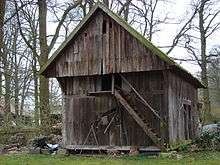Treppenspeicher
A Treppenspeicher (literally "staircase store") is the German term for a granary or secondary farm building used for storage and typical of the Lüneburg Heath area in northern Germany. The upper storey of the store was usually accessed via a flight of steps on the outside of the building, usually at one of the gable ends, thus giving the building its name.
Description
Treppenspeicher are only relatively small buildings. They are witness to the craftsmanship of carpenters in the farming community. Their solid, wooden construction ensured that the interior stayed dry and they were so tightly planked that the stored produce was protected from mice. These stores used to be built within sight, but at a distance from the main farmhouse. This ensured that, if the farmhouse caught fire, the fire would not spread to the stores.
Treppenspeicher were typical of the Lüneburg Heath. Here they remained in use until well into the 19th century. They increasingly disappeared however because they are no longer practical today. Nowadays the store rooms are normally part of the farmhouse itself.
In former times there was at least one, but usually several, stores on each heath farm, serving all sorts of purposes. They were used to store grain, buckwheat, flax, cotton, linen, wool, honey, meat, bacon and clothes. They were often used as sleeping accommodation for the farmhands.
Gallery
- Old ''Treppenspeicher'' on the Lüneburg Heath
-

400-year-old Treppenspeicher on the Hiesterhof
-

1709 Treppenspeicher in Oberohe
-

1767 Treppenspeicher in Baven
-

1808 Treppenspeicher in Weesen
-
Protected 1839 Treppenspeicher in Bollersen (Celle county)
-
Treppenspeicher in Wilsede
Bibliography
- Stuhrwohldt, Alfred (1936). Die Treppenspeicher in der Lüneburger Heide, Brunswick: TH Carola-Wilhemina.